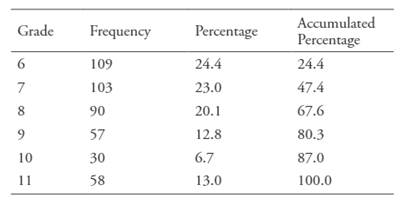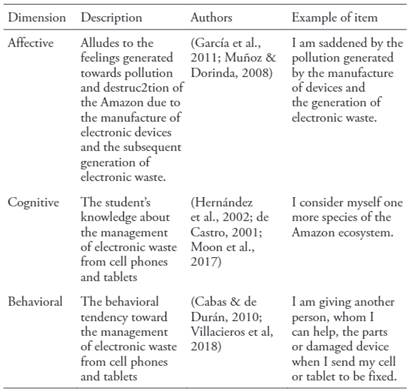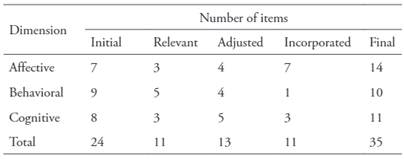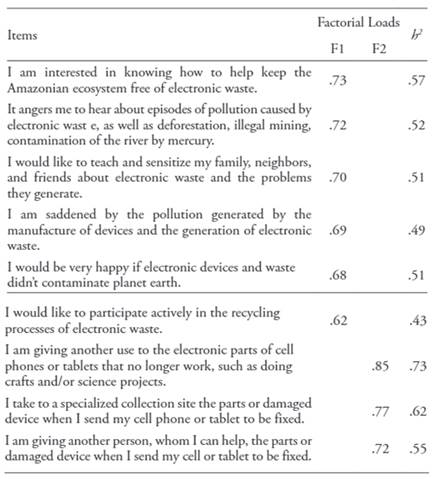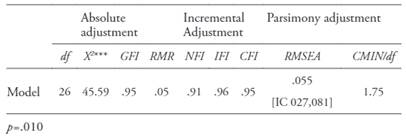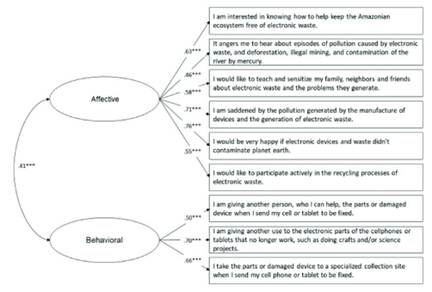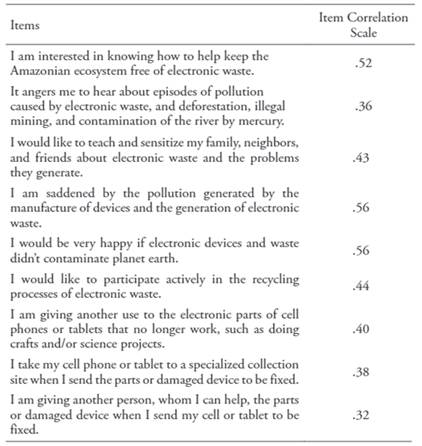Electronic waste generation is expected to increase due to the excessive development of Information and Communications Technologies (ICT). This type of waste includes contaminants and harmful elements, including lead, chromium, mercury, cadmium, and arsenic. Some of these metals persist in the environment and result in contamination through bioaccumulation in plants and animals (Jara, 2017; Londoño et al., 2016). Furthermore, the manufacture of electronic devices requires elements that when extracted destroy ecosystems, river basins, and protected areas, in most cases due to the illegal extraction of minerals, especially in the Amazon (Mongabay-Latam, 2018).
Meanwhile, human beings are unaware of the socio-environmental implications of generating this type of unconventional waste (Pascuas, Cruz et al., 2018). As a response, UNESCO (2017) states within its sustainable development goals that action must be taken on behalf of the climate and to protect the use of sustainable terrestrial ecosystems. According to the above, it is preponderant to analyze environmental behaviors and attitudes, given the deterioration that human beings are causing to ecosystems, especially if one takes into account what is causing the production of electronic devices and the generation of electronic waste.
In the attempt to minimize the negative impact on the environment, instruments have been developed and validated to assess environmental attitudes, thus having, for example, an instrument for measuring pro-environmental attitudes in Venezuelan schoolchildren (Campos et al., 2008). Other research includes an environmental attitudes questionnaire (Corraliza & Berenguer, 1998), attitudes towards electronic waste recycling in Mexico (Arroyo, 2014), environmental attitudes of children in school (Izadpanahi & Tucker, 2018; Wu, 2012), attitudes of high school students (DeWaters et al., 2013; Zamorano et al., 2012), of young university students (Herrera et al., 2016), measurements of the environmental literacy of teachers (Aznar et al., 2019; Boubonari et al., 2013; Farida & Hadiansah, 2019) and the measurement of eco-spirituality (Suganthi, 2019).
The lack of such scales adapted to the characteristics of the Amazon region, its type of population, and the need to collect information about the problem is significant evidence of the absence of instruments that address the issue of electronic waste. Therefore, this research is geared towards determining the psychometric properties of an instrument to measure attitudes that adolescents (high school students) have toward the management of electronic waste from cell phones and tablets.
Attitudes for prioritizing the environment
Attitudes are part of human life and behavior; they are learned and acquired in the course of social interactions in various spaces. As they are learned, they are likely to be modified. Hence, there is evidence that attitudes formed on the basis of experiences are stronger in behavior; that is why intense attitudes have a more significant impact on behavior and are more resistant to change. Attitudes are seen as one of the key aspects that are addressed in environmental education for the construction of environmental culture. At the same time, environmental education has been defined as an active methodology for changing attitudes and instilling values favoring the environment, especially in young students. What is sought is to achieve a healthier behavior of the human being in his interactions with the environment (Castanedo, 1995).
In turn, Rokeach (1968) considers attitudes as the organization of various beliefs centered on a specific consideration (physical or social, concrete or abstract, for example), which predisposes a person to respond in a certain way through an action. Attitudes are considered to be manifestations and indicators of the conscious experience, the verbal behavior and daily behavior of a subject or group of them about a situation, object or another person, in order to develop an emotion, learn new knowledge and, above all, to take action. This is how attitudes could be modified over time, through persuasive strategies in propitious moments (Briñol et al., 2002; Taborda & Gonçalves, 2020; Pereyra et al., 2019).
In the meantime, attitudes have a structure made up of three components that interact with each other. The first is the cognitive component that is composed of the beliefs, perception, information, and knowledge that one has about an object. The second component is the affective, considered as the feeling that evaluates the level of liking or displeasure with a social object. Finally, the third component is the behavioral, defined as the tendency and willingness to react, in a certain way, to objects. This dimension also covers both the intentions of conduct and the actions (Aigneren, 2008).
Therefore, an environmental attitude is defined as a predisposition towards actions for or against the environment, and for this reason, an attitude attends the learnings or beliefs about the subject and the willingness (favorable or unfavorable) to act in a determined direction. Positive environmental attitudes are the opinions that are held about protecting the environment and conserving resources, and they influence behaviors. Beliefs and attitudes influence values and, in turn, affect the way of life of human beings and their environment (Camacho & Jaimes, 2016).
In relation to the above, Álvarez & Vega (2009) define the environmental attitude as “the favorable or unfavorable feelings that are held towards some characteristic of the environment or towards a problem related to it” (p. 247); it is characterized by being a direct determinant of the predisposition towards actions in favor of the environment. The attitudes and the intention to act have a significant influence on behavior when other factors do not prevent it from taking place.
However, it is indicated that there is no correspondence between what humans know and the attitudes with respect to environmentally responsible behavior. There is evidence that interventions to guide environmental education with attitudes do not always give rise to environmentally friendly behaviors, creating an inconsistency between environmental attitudes and behavior. For this reason, lasting changes must be generated in people’s behavior; since attitudes are those that determine it, they are the elements necessary for changing environmental behavior. It is concluded that behavior is a manifestation of attitude (Páramo, 2017).
In this sense, given the complexity of measuring aspects that could be framed as attitudes, measurement techniques that use scales arise. The scales allow variable attitudinal values to be represented by a score, usually in “questionnaires composed of a set of questions that have a structure of items or propositions used to quantify characteristics or variables of social behavior” (Aigneren, 2008, pp. 1-2).
However, considering that in some cases, people tend to give socially acceptable answers, there may be an incongruity between what a subject expresses that he does and what he actually does, implying that he is better than he is actually, even in anonymity (Castanedo, 1995). Hence, humanity’s challenge in the face of the environmental crisis is to have the coexistence of a high degree of concern and the capacity for social change so that there is a powerful effect that results in environmental sustainability (Moreno et al., 2005).
Method
A quantitative study was conducted with a defined scope and a trans-sectional survey design. This type of research design is commonly used in social or behavioral science research and consists of the application of surveys or instruments for measuring variables of interest, where quantitative or numerical data are collected which will ultimately be analyzed quantitatively (Creswell, 2009; Ornstein, 2013; Ruel et al., 2016).
Sample
A non-probabilistic sampling was used for convenience, where there was a collaboration of 447 students, of whom 231 (51.7%) were male and 216 (48.3%) female; they also reported ages of 13.9 years (SD=1.7) and 13.5 (SD=1.94), respectively. Participants were from two public high school in Florence Caquetá, Colombia; 359 (80.3%) attended the one educational institution, and 88 (19.7%) were enrolled in other educational institution. There were six different grades represented (See Table 1).
Measures
The instrument had as a starting point the proposal of Pascuas, Chico et al. (2018) in terms of identifying the incidence of the level of schooling in attitudes and perceptions about managing this type of waste. A survey-type instrument was organized and adapted with 24 items to be measured using a Likert scale ranging from a value equal to 0 (totally disagree) to 4 (totally agree). It should be noted that easy-to-understand words and sentences were used for the students; attitudes towards the use of electronic waste, specifically, cell phones and tablets, were defined.
In addition to the above, an exercise in the operationalization of the variable was carried out, where was presented the description or theoretical definition of the different measured dimensions, the authors who supported the said construction, and an example of the behavior (item) that is measured (see Table 2).
Procedure
The following steps were carried out for the purpose of this study:
(1) Request authorization from the directors of the educational institutions.
(2) Delivery of the consent form informing the parents about the voluntary participation of students.
(3) Adaptation of the measuring instrument from the Google docs online forms.
(4) Application of the measuring instrument to the students in the computer room of the respective institutions.
(5) Data capture and analysis, using the Statistics and AMOS statistical packages from the software, Statistical Package for the Social Sciences (SPSS) version 26.
(6) Interpretation and publication of results.
Data analyses
Was performed the Exploratory Factor Analysis with Principal Components extraction method and Varimax orthogonal rotation, to determinate construct validity; likewise, was used the Blartlett sphericity test and Kaiser-Meyer-Olkin values to evaluate the model fit and the pertinence.
On the other hand, was used Confirmatory Factor Analysis with structural equation modeling and supported by SPSS AMOS version 26. To determinate the suitability of the model, the following index were evaluated:
Absolute adjustment index:
Likelihood ratio (X2)
Discrepancy between variance and covariance matrices (CMIN / df)
Goodness of fit (GFI)
Root Mean Square Residual (RMR)
Incremental adjustment index:
Normed Fit Index (NFI)
Incremental Index of Fit (IFI)
Comparative Fit Index (CFI)
Parsimony index
Root mean square of approximation (RMSEA)
Finally, the reliability was evaluated by the internal consistency index obtained using the Cronbach’s alpha.
Results
Content Validity
This activity involved eight professors with research experience in the fields of education, environment, and technology; they were representatives of five different recognized universities in Mexico, Brazil, and Colombia. The judges were given a battery of 24 items organized in three dimensions; namely, affective, cognitive, and behavioral.
With respect to the opinion, comments, observations, and suggestions received by the participating experts and in accordance with Escobar and Cuervo (2008), if 80% of the experts have agreed on the validity of an item, it can be incorporated into the instrument; otherwise, it must be modified, adjusted, or relocated among the three components and/or new items in the instrument must be created. In general, 18 attitudes met this criterion. Table 3 summarizes the decisions of the experts to make changes to the attitudes contained in the instrument; the actions carried out as a result of this revision led to the adjustment of items and the drafting of new attitudes, resulting in an increase in the number of items in the instrument.
Construct Validity
Exploratory factorial analysis
The Exploratory Factor Analysis (EFA) was performed using the method of extraction from a principal components analysis and a Varimax rotation. The results of the Bartlett Sphericity test (χ 2 = 470.87, p ≥.000, gl=36) and the Kaiser-Meyer-Olkin (KMO) value of .82 serve as evidence to claim that the proposed model has a good fit (Cea, 2002; Martínez et al., 2009).
In addition, two criteria were used for the inclusion of items: (1) factorial load greater than .40, a criterion suggested for samples of 200 participants (Hair et al., 1999) and (2) communalities greater than .30 and less than .75 (De Vellis, 2009; Field, 2009). Once these criteria were met, a two-factor solution was obtained that explains 55.17% of the variance with nine items (Merenda, 1997) (Table 4).
Confirmatory factor analysis
According to the results of the EFA, a model to measure “high school students’ attitudes toward electronic waste management” is proposed, which is composed of two factors: (1) the behavioral approach and (2) the affective approach (see Figure 1).
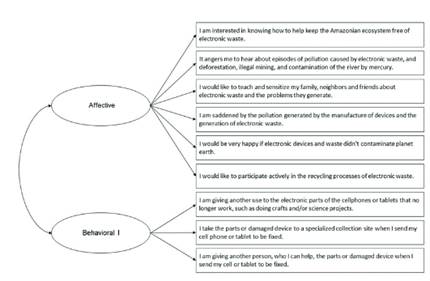
Figure 1 A theoretical model for measuring adolescent attitudes towards electronic waste management.
Subsequently, for the verification of the model, an exercise of structural equations was performed, where the method of maximum likelihood estimation was used for the determination of the goodness of fit between the theoretical model and the empirical, thus obtaining a satisfactory adjustment, which can be seen in the indices presented in Table 5.
From the results shown above, it is possible to affirm that there are no significant discrepancies between the variance-covariances matrices observed and those predicted by the model; this assertion is also based on correlations between the factors and significant regression coefficients (see Figure 2).
Reliability
Reliability was determined through the analysis of internal consistency using Cronbach’s alpha. In Table 6, it is possible to observe that the correlations between the elements exceed the minimum value of .30 determined for consideration in the analysis, while the scale shows a reliability of .75, resulting in an acceptable score according to (De Vellis, 2009).
Conclusions
Proposing and discussing experiences of attitudes towards the use of mobile devices and things related to electronic waste is an emerging topic little consolidated. Similarly, there are not enough studies analyzing attitudes towards the management of electronic waste from and for the Colombian Amazon region. This is how, in the face of the environmental problems generated by this type of waste, the need and urgency to develop this kind of research for the entire population is evident.
The instruments for determining psychometric properties and the measurement scales are a priority for addressing environmental issues. The contribution of instruments that measure attitudes towards environmental conservation is broad and undeniable; however, not all report evidence of the validity and reliability of the data they collect, which leaves in doubt the results that are derived from them. Additionally, there are those that only report reliability (Campos et al., 2008; Corraliza & Berenguer, 1998; Farida & Hadiansah, 2019; Herrera et al., 2016; Zamorano et al., 2012), although these have results that may be considered desirable in terms of internal consistency, i.e., scores less than .90. On the other hand, two instruments have been found that, in addition to reliability, add evidence of construct validity, where one reports a scale with 14 items with low reliability and explaining minimal variance through a method of extraction that, in this last item, is flexible (Izadpanahi & Tucker, 2018). Finally, a survey was analyzed that used Exploratory Factor Analysis, resulting in four subscales with regular KMO scores and some desirable Confirmatory Factorial Analysis indices of adjustment (Aznar et al., 2019).
The analysis of the instrument resulted in an empirically sustainable and parsimonious two-dimensional measurement model, given that it consists of a total of nine items. The adjustment of the instrument to measure attitudes in adolescent students determines that it is sustainable to be used. Despite being a two-dimensional instrument, it would support decision-making in research. It is therefore recommended to continue with this instrument and confirm the presented results of environmental attitudes of adolescent high school students towards electronic waste management. In addition, this would allow teachers and researchers to gather evidence on environmental issues, highlighting that it is likely to be improved with new validation processes.
This analysis helps to explore and identify characteristics of attitudes towards electronic waste among high school students in Florence Caquetá, a population group similar to many others in Colombia and Latin America. This indicates that the construction of a theoretical model that includes the identified factors should be continued. In this way, its usefulness is multiplied, serving both the purposes of research and the construction of environmental culture. Finally, quantitatively understanding attitudes could play an important role among the adolescent students; indeed, through the quantification and application, various factors could be identified (personal, school, family, sociodemographic, contextual) to which environmental educational strategies should be targeted and prioritized.














